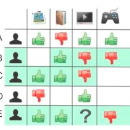Collaborative filtering is one of the most influential recommender system types. Various methods have been proposed for collaborative filtering, ranging from matrix factorization to graph convolutional methods. Being inspired by recent successes of GF-CF and diffusion models, we present a novel concept of blurring-sharpening process model (BSPM). Diffusion models and BSPMs share the same processing philosophy in that new information is discovered (e.g., a new image is generated in the case of diffusion models) while original information is first perturbed and then recovered to its original form. However, diffusion models and our BSPMs deal with different types of information, and their optimal perturbation and recovery processes have a fundamental discrepancy. Therefore, our BSPMs have different forms from diffusion models. In addition, our concept not only theoretically subsumes many existing collaborative filtering models but also outperforms them in terms of Recall and NDCG in the three benchmark datasets, Gowalla, Yelp2018, and Amazon-book. Our model marks the best accuracy in them. In addition, the processing time of our method is one of the shortest cases ever in collaborative filtering. Our proposed concept has much potential in the future to be enhanced by designing better blurring (i.e., perturbation) and sharpening (i.e., recovery) processes than what we use in this paper.
翻译:合作过滤是最具影响力的建议系统类型之一。 已经为合作过滤提出了各种方法,从矩阵因数化到图表进化方法。 受最近GF-CF和扩散模型的成功启发,我们提出了一个模糊隔环过程模型的新概念。 传播模型和BSPMs在发现新信息时分享了相同的处理理念(例如,在传播模型中生成了新的图像),而原始信息先是被扰动,然后又恢复到原始形式。 然而,传播模型和我们的BSPMS处理不同类型的信息,而它们的最佳扰动和回收过程也存在根本差异。 因此,我们的BSPMs与扩散模型有不同的形式。 此外,我们的概念不仅在理论上包含许多现有的协作过滤模型,而且在新发现的三个基准数据集Gowalfaa、Yelp2018和Amazon-book中也超越了它们。 我们的模型标记了它们中的最佳准确性。 此外,我们的方法的处理时间与传播模型相比,我们的方法在最短的过滤中,通过改进了我们未来的模型。 改进了我们的方法, 改进了我们的方法, 改进了我们的方法的升级了我们的未来概念。





